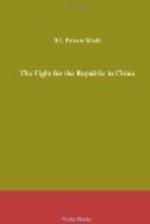Here is the stuff of which the whole incident was made: there is nothing material beyond the facts stated which illustrate very glaringly the manner in which a strong Power acts towards a weak one.
Meanwhile the effect in Tokio of these happenings had been electrical. Relying on the well-known Japanese police axiom, that the man who gets in his story first is the prosecutor and the accused the guilty party, irrespective of what the evidence may be, the newspapers all came out with the same account of a calculated attack by “ferocious Chinese soldiers” on a Japanese detachment and the general public were asked to believe that a number of their enlisted nationals had been deliberately and brutally murdered. It was not, however, until more than a week after the incident that an official report was published by the Tokio Foreign Office, when the following garbled account was distributed far and wide as the Japanese case:—
“When one Kiyokishy Yoshimoto, aged 27, an employe of a Japanese apothecary at Chengchiatun, was passing the headquarters of the Chinese troops on the 13th instant, a Chinese soldier stopped him, and, with some remarks, which were unintelligible to the Japanese, suddenly struck him on the head. Yoshimoto became enraged, but was soon surrounded by a large number of Chinese soldiers and others, who subjected him to all kind of humiliation. As a result of this lawlessness on the part of the Chinese, the Japanese sustained injuries in seven or eight places, but somehow he managed to break away and reach a Japanese police box, where he applied for help. On receipt of this news, a policeman, named Kowase, hastened to the spot, but by the time he arrived there all the offenders had fled. He therefore repaired to the headquarters of the Chinese to lay a complaint, but the sentry stopped him, and presented a pistol at him, and under these circumstances he was obliged to apply to the Japanese Garrison headquarters, where Captain Inone instructed Lieutenant Matsuo with twenty men to escort the policeman to the Chinese headquarters. When the party approached the Chinese headquarters, Chinese troops began to fire, and the policeman and others were either killed or wounded. Despite the fact that the Japanese troops retired, the Chinese troops did not give up




